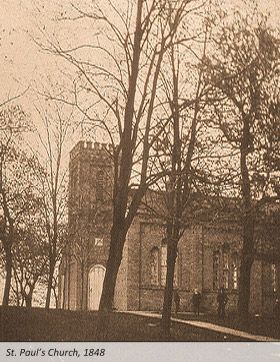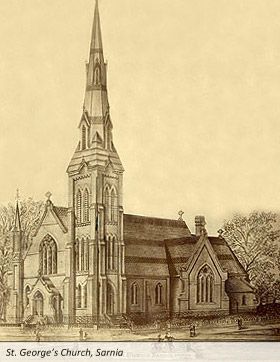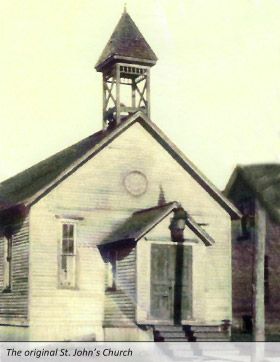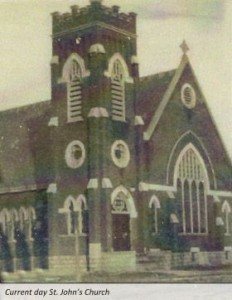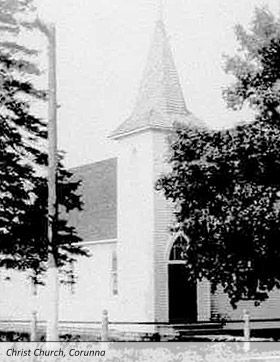CREATING ALL SAINTS’ PARISH
History of the Amalgamation of St George’s, Sarnia;
St John’s, Sarnia; and Christ Church, Corunna
“The believers were of one heart andsoul,
everything they had was held in common,
and great grace was upon them all.
There was not a needy person among them.”
Acts 4: 32a, 33b, 34a.
As Canada grew from a colony into a country, and the population increased in certain growth areas in southwestern Ontario, two of the towns that were formed came to be called Sarnia and Corunna and some of the settlers organized themselves from house gatherings with itinerant preachers into Anglican parishes that eventually grew to six Anglican church buildings in Sarnia and one in Corunna.
For many yearsthe attendance at the organized churches continued to increase. Changes in lifestyles during the 1900s impacted church attendance negatively until, sometime early in the 2000s, as a result of growing concern among leaders and members of the Anglican Diocese of Huron, it seemed time, with God’s guidance, for local conversations regarding how to adjust to the changing demographics.
In the case of three of the Anglican Churches in Sarnia and Corunna, Ontario, including the parishes of Christ Church, Corunna; and St. George’s and St. John’s, Sarnia, our journey towards amalgamation began in November 2008 when Archdeacon Salt called the six parishes in Sarnia and one in Corunna, which he paired into three groups, to meet to discuss our various situations with regard to our aging congregations and our diminishing number of members and how we might provide support to one another.
- Following that meeting, St. George’s and St. John’s, Sarnia and Christ Church, Corunna, formed a core committee of wardens and Rectors from the three parishes which we called the “Planning Group for Amalgamation”, the PGA for short.
- Throughout the process reports were presented to the congregations on a regular basis to keep them abreast of PGA’s progress.
- A motion was presented, and carried unanimously, at the three annual vestry meetings in January 2009 to determine if it was feasible and desirable for us to continue the process of developing a closer relationship within the three congregations.
- ThePlanning Group’s objective was to paint an action picture of what anamalgamated parish might “look like” as the first step towards possible amalgamation.
- As a starting point, it was agreed that it was necessary for our parishioners to “get to know one another” as a basis for determining how and if to go forward.
- The Rector of St. George’s, The Ven. Jim Dugan, Archdeacon of Lambton-Kent, drafted a “timelines” worksheet as a general guide to what and when certain steps were to be undertaken.
- A pivotal point in our journey was a retreat day for our three parish councils –a very positive beginning for any parish contemplating a major change – Rev. Jawn Kolohon provided strong leadership by introducing the three councils to each other on a very basic level spiritually, worshipfully and socially – the insights gained through this sharing convinced us all that our fit was good on all the important fundamental issues and they served to strengthen the parish leaders’ conviction that we had a good basis for building an amalgamation plan to present to our members.
- Joint activities involving our three parishes were undertaken in all areas of our church life throughout our planning process.
- Subcommittee groups of parishioners representing the significant areas of ourchurch life were formed to provide a forum for working together and developing familiarity among the members as well as to identify any insurmountable impediments to our possible amalgamation.
- This undertaking turned out to be a mixed blessing as members began deviating from the overall plan in an attempt to micromanage the ways a new parish should operate. The planning group was able to help resolve most of the misunderstandings in order to bring the discussions to completion with reasonable conclusions and some positive recommendations for going forward
- The differences that were experienced pointed to areas needing special attention. One fundamental difference emerged regarding trust. Some outside assistance wasrequired to help us to understand and to begin building trust, an essential andtime consuming process, which took a lot of determination. Together, we turned to God in prayer for guidance.
- The motion, at the January 2010 Annual Vestry meetings at each of the three parishes, to plan for an amalgamation vote was carried.
- The bumps in the road that were encountered forced us to be open, honest, realistic and understanding – strengthening our basis for going forward, and ultimately resulting in a strong, amalgamated parish.
- Thev oting date was set and published and ended in an overwhelming YES to amalgamate. The amalgamation would become effective on February 1, 2011.
- Following the vote, we all joined in a service of thanksgiving.
Following the completion of the service, we adjourned to the parish hall to choose the name for the new parish – everyone appeared happy and greeted each other enthusiastically. The names nominated by the parish members that were acceptable to the Bishop were posted on the walls around the room. Good spirits erupted on all sides and there was much laughing and chanting of our chosen names to try to persuade others to join with us. In the end there was a motion to make the name choice of All Saints’ unanimous and it was carried with much cheering. We experienced a unique moving of God’s spirit amongst us and we are still commenting on how good it was to feel ourselves being drawn together.
We viewed our transition period, as we worked tobecome a strong, integrated parish, as a critical time for us. Our next steps were to form a Hospitality Group to act as hosts and hostesses throughout the first transition year. Particular attention paid to planning events, the provision of name tags for all our members, ensuring the inclusion of all in the activities, having welcoming greeters at services, PGA members mixing with the crowd at coffee hours and generally “working the room” whenever we were together. This was our one opportunity for our three congregations to meld into one strong parish and we were committed to working hard on our transition.
The planning committee appreciated the strong support of our two Rectors, Archdeacon Jim Dugan and Canon Nick Wells that was invaluable. They gave generously of their time and considerable talents and we thank God for their guidance throughout this journey.
The success of any amalgamation depends heavily upon strong support and guidance from the Rectors of the participating parishes in addition to strong lay leadership.
Our Rectors have guided us through aninteresting mix of worship styles flavoured by specialty presentations bothmusically and dramatically.
Since amalgamation, All Saints’ Parish inSarnia and Corunna has continued to strengthen both socially and spiritually.
Enthusiasm is evidenced in the new Parish through strong numbers of regular worshippers at weekly services and general participation at all types of meetings. There is a general willingness ofmembers to volunteer their time and energy to proposed projects. We enjoyworking together in activities such as reaching out to others through our Mission Group and fund raising by presenting coffee hours and bazaars to the public.
We have experienced God’s guidance throughout our amalgamation process and are thankful that, by His grace, All Saints’ Parish, Sarnia-Corunna, is a vibrant, active, fun-loving and welcoming parish.
Come and see foryourself some Sunday!
June 2017
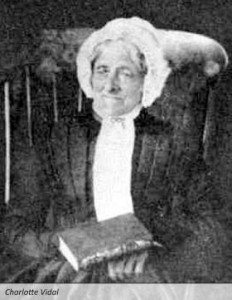
St George’s, Sarnia
1835 the local members of the United Church of England and Ireland met in Mooretown to organize and establish the parish of Moore. This parish provided missionaries to Moore, Port Sarnia, and Walpole Island until 1848. During this time services were conducted in the homes of people and a building known as “The Chapel” a building near the corner of Lochiel and Brock Streets, which was available to various denominations.
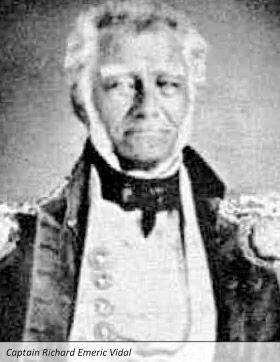
In 1848 Captain Richard Emeric Vidal, R.N. a retired naval officer, and one of the founders of Sarnia, purchased one acre of land on the north side of the London Road and built, at his own expense, a red brick church which accommodated one hundred people. The contractor was Alexander MacKenzie who became the second Prime Minister of Canada. There was no written contract for the erection of the building; the costs being agreed to verbally, and, on completion, there were no extra expenses. This original church was known as St. Paul’s under the leadership of the Reverend G.J.R. Slater. It was renovated in 1857 with the addition of wooden transepts to increase the seating capacity. The current site on the corner of Vidal Street and Charlotte Street was purchased in 1882. The cornerstone of the new church to be named St. George’s was laid by Bishop Hellmuth. On June 22nd the Right Reverend M.S. Baldwin, Bishop of Huron, the Very Reverend Dean Boomer, the Reverend William Davis, father of the Rector, officiated at the opening of the new church. St. Paul’s was occupied for the last time on May 13th 1889, sold and demolished.
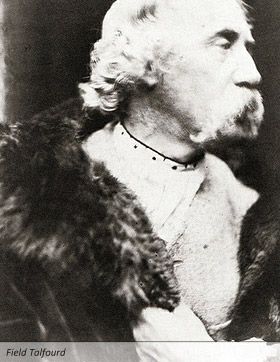
Christ Church, Corunna
Christ Church Corunna was opened for Divine Service on August 11, 1861 and consecrated by Bishop Cronyn on October 4, 1863. It was at this time that the silver communion service consisting of two silver chalices, a paten and wine flagon were given to the church by Froome Talfourd Esq. to commemorate the opening of the church. The church originally was a framed and clapboard structure that stood facing Hill Street about twenty five feet west of its present location. The original building was torn down and a smaller church rebuilt in 1905 and consecrated by Archdeacon Richardson on July 2, 1905. A number of local structures were purchased, moved and attached to the church during the twentieth century to create an office, boardroom, kitchen, parish hall and bathrooms. Froome and his brother Field Talfourd donated land for a cemetery which is located at the end of Church Street in the little community known as Froomefield north of Corunna along the St. Clair river.
St John’s, Sarnia
A mission Chapel, St John’s, was established by the Warden’s of St George’s in 1892 in the south end of Sarnia. The first morning and evening services took place on January 16th 1898. The Vestry of St George’s on June 20th 1889 decided to deed the property for the mission Chapel to the Synod of Huron which in turn deeded it to the new parish to become known as St John’s, South Sarnia. On November 28th 2010 at a special Vestry, the congregations of Christ Church, Corunna, St John’s, Sarnia and St George’s, Sarnia voted to amalgamate, selecting the name All Saint’s.

